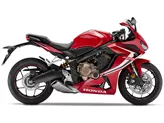Yamaha R1 2011 vs. Kawasaki Ninja 650 2017

Yamaha R1 2011

Kawasaki Ninja 650 2017
Overview - Yamaha R1 2011 vs Kawasaki Ninja 650 2017
The Yamaha R1 2011 and the Kawasaki Ninja 650 2017 are both popular models in their respective categories, but they have distinct differences in terms of specifications and performance.
Starting with the engine and drive train, the Yamaha R1 2011 is equipped with a 998cc, 4-cylinder engine that produces an impressive 181 horsepower and 115.5 Nm of torque. On the other hand, the Kawasaki Ninja 650 2017 features a smaller 649cc, 2-cylinder engine that generates 68.2 horsepower and 65.7 Nm of torque. The Yamaha R1 clearly outperforms the Ninja 650 in terms of power and torque.
In terms of suspension, the Yamaha R1 2011 comes with an upside-down telescopic fork, providing excellent stability and control. The Kawasaki Ninja 650 2017, on the other hand, features a telescopic fork, which may not offer the same level of performance as the R1's suspension.

Yamaha R1 2011
When it comes to the chassis, the Yamaha R1 2011 boasts an aluminum frame, specifically a Deltabox frame, which is known for its rigidity and lightweight construction. The Kawasaki Ninja 650 2017, on the other hand, has a steel frame, which may not offer the same level of agility and responsiveness as the R1's frame.
Both models feature double disc brakes at the front, ensuring excellent stopping power. However, the Kawasaki Ninja 650 2017 is praised for its excellent brakes, which provide a strong and responsive feel.
In terms of dimensions and weights, both models have similar front tire widths and diameters. However, the Yamaha R1 2011 has a wider rear tire compared to the Ninja 650 2017. Additionally, the R1 has a slightly longer wheelbase and a higher seat height, which may affect the overall handling and comfort for some riders.
Lastly, the Yamaha R1 2011 is equipped with an 18-liter fuel tank, offering a larger capacity compared to the Ninja 650 2017's 15-liter tank. This may be beneficial for riders who prefer longer rides without frequent refueling.

Kawasaki Ninja 650 2017
In terms of strengths, the Yamaha R1 2011 is praised for its fine traction point, easy rider adaptation to the race track, easy steering behavior, and optimal traction point. On the other hand, the Kawasaki Ninja 650 2017 is commended for its transparent chassis for sport, playful and good-natured handling, excellent brakes, sharp looks resembling the ZX-10R, and a resilient engine.
In terms of weaknesses, the Yamaha R1 2011 is criticized for its plump-looking rear end, which may not appeal to some riders. The Kawasaki Ninja 650 2017, on the other hand, is noted for its lack of sound from the stock exhaust and slight vibrations from the engine.
In conclusion, the Yamaha R1 2011 and the Kawasaki Ninja 650 2017 are both impressive models in their respective categories. The R1 offers superior power and performance, while the Ninja 650 provides a more playful and agile riding experience. Ultimately, the choice between the two will depend on the rider's preferences and priorities.
Technical Specifications Yamaha R1 2011 compared to Kawasaki Ninja 650 2017
Pros and Cons in comparison
Pros and Cons in comparison
Yamaha R1 2011

Once upon a time, she was the toughest beast among the 1000s. Only the wildest dogs could ride it. Now it is the motorbike that can not only be described as "the least evil on the country road" but which also gives a lot of pleasure there.
Kawasaki Ninja 650 2017

The Ninja 650 firmly stamps its predecessor (Er-6f). The engine has mastered the Euro 4 hurdle well and serves up a very usable 68 hp, the chassis is simply great for this class, and the weight reduction of 18(!) kilos compared to the ER-6f justifies reverent nods.
Price Comparison Avarage Market Price Yamaha R1 vs Kawasaki Ninja 650
There are a few key differences between a Yamaha R1 2011 and a Kawasaki Ninja 650 2017. In terms of price, the actual average price of a Yamaha R1 2011 is about 34% higher. A Yamaha R1 2011 experiences a loss of 1,100 USD in one year and 1,850 USD in two years of ownership. This is offset by a loss of 380 USD and 500 USD for a Kawasaki Ninja 650 2017. Compared to Kawasaki Ninja 650 2017 there are less Yamaha R1 2011 bikes available on the 1000PS.de Marketplace, specifically 4 compared to 7. It takes less time to sell a Yamaha R1 with 53 days compared to 96 days for a Kawasaki Ninja 650. Since model year 2005 1000PS.de editors have written 80 reviews for the Yamaha R1 and 20 reviews for the Kawasaki Ninja 650 since model year 2017. The first review for the Yamaha R1 was published on 4/28/2003 and now has more than 3,900 views. This compares to more than 79,600 views for the first review on Kawasaki Ninja 650 published on 10/4/2016.






















